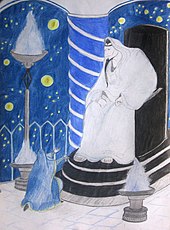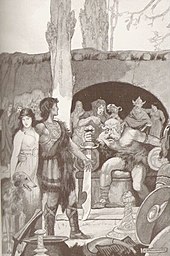
Lúthien and Beren

| Lúthien | |
|---|---|
| Tolkien character | |
| In-universe information | |
| Aliases | Tinúviel |
| Race | Maia / Elf |
| Gender | Female |
| Book(s) | The Silmarillion Beren and Lúthien |
| Beren | |
|---|---|
| Tolkien character | |
| In-universe information | |
| Aliases | Erchamion |
| Race | Men (Edain) |
| Gender | Male |
| Book(s) | The Silmarillion Beren and Lúthien |
Lúthien and Beren are characters in J. R. R. Tolkien's fantasy world Middle-earth. Lúthien is an elf, daughter of the elf-king Thingol and goddess-like Melian. Beren is a mortal man. The complex tale of their love for each other and the quest they are forced to embark upon is a story of triumph against overwhelming odds but ending in tragedy. It appears in The Silmarillion, the epic poem The Lay of Leithian, the Grey Annals section of The War of the Jewels, and in the texts collected in the 2017 book Beren and Lúthien. Their story is told to Frodo by Aragorn in The Lord of the Rings.

The story of Lúthien and Beren, immortal elf-maiden marrying a mortal man and choosing mortality for herself, is mirrored in Tolkien's The Tale of Aragorn and Arwen. The names Beren and Lúthien appear on the grave of Tolkien and his wife Edith.

Scholars have noted the many sources that Tolkien used in constructing the story. It is based principally on the classical tale of Orpheus and Eurydice in the underworld, supplemented by multiple story elements from myths, legends, and folktales from different periods. These include the Finnish Kalevala, the Welsh Mabinogion, the Saga of the Volsungs, the Prose Edda, and the folktale "Rapunzel".

Context
Lúthien was a Telerin (Sindarin) princess, the only child of Elu Thingol, king of Doriath, and his queen, Melian the Maia, making her half-royal, half-divine. She was born in the Years of the Trees, according to the Grey Annals. At her birth, the white flower niphredil bloomed for the first time in Doriath. Lúthien's romance with the mortal man Beren is considered the "chief" of the Silmarillion tales by Tolkien himself; he called it "the kernel of the mythology".[T 1] Elrond was Lúthien's great-grandson and Aragorn was descended from her via Elros and the Royal Family of Númenor. She is described as the Morning Star of the Elves and as the most beautiful daughter of the one god, Ilúvatar. Beren was the son of Emeldir and Barahir, a man of the royal House of Bëor of Dorthonion.[T 2]

In contrast, Lúthien's descendant Arwen was called Evenstar, the Evening Star of the Elves, meaning that her beauty reflects that of Lúthien. Lúthien was first cousin once removed of Galadriel (also Arwen's grandmother), whose mother, Eärwen of Alqualondë, was the daughter of Thingol's brother. The story of Lúthien and Beren is mirrored in The Tale of Aragorn and Arwen.[T 3][1]

Etymology
The name Lúthien appears to mean "daughter of flowers" in a Beleriandic dialect of Sindarin, but it can also be translated "blossom".[2] The epithet Tinúviel was given to her by Beren. It literally means "daughter of the starry twilight", which signifies "nightingale". The name Beren means "brave" in Sindarin.[T 4]

Fictional biography
Meeting

Beren saw Lúthien dancing under moonrise in her father's forest, and fell in love with her, captivated by her beauty. He stood in the shadows wishing to be near enough to Lúthien to touch her, but Daeron, her childhood friend and partner in music and dance, noticed Beren and, believing him to be a wild animal, shouted for Lúthien to flee. She saw Beren's shadow and ran away. One day in summer when Lúthien was dancing on a green hill surrounded by hemlocks,[3] she sang, awakening Beren. He ran to her, and again she tried to escape and he cried Tinúviel. When Lúthien gazed upon him she reciprocated his love. He kissed her, but she slipped away and he fell into a deep sleep. In his hour of despair, she appeared before him, and in the Hidden Kingdom of Doriath set her hand in his and cradled his head against her breast. From then on they met secretly.[T 2]

The quest of the Silmaril
Daeron, who also loved her, reported her meetings with Beren to her father. Though Melian warned her husband against it, Thingol was determined not to let Beren marry his daughter, and set a seemingly impossible task as the bride price: Beren had to bring him one of the Silmarils from Morgoth's Iron Crown.[T 2]

Vision and imprisonment
Lúthien had a vision of Beren lying suffering in the pits of Sauron, Lord of Werewolves. Her mother told her that Beren was captive in Sauron's dungeons. Lúthien decided to save Beren, asking Daeron for help, but he betrayed her to Thingol. Thingol then had her guarded in the high branches of a beech tree. Daeron was filled with remorse; Lúthien forgave him and devised a plan to escape. She enchanted her hair into a cloak to lull her guards to sleep, and ran from her prison.[T 2]

On her way to rescue Beren, she found Huan, the Hound of Valinor, and was taken to his master Celegorm. He, plotting to force her to marry him, offered to help her, asking her to follow him to Nargothrond. When she arrived, Celegorm held her hostage and forbade her to talk to anyone else. Huan took pity on her, betraying his master, and freed her. Huan was granted the power to speak, and together they escaped from Nargothrond.[T 2]

They came to Sauron's Isle, and Lúthien sang a call to Beren. He answered, but Sauron heard her song and sent wolves to slay Huan, but Huan killed them, one by one. Finally, Sauron transformed himself into the most powerful of all werewolves and went out. Huan flinched, but Lúthien smothered Sauron's lunge in her enchanted cloak. Sauron changed into different shapes, but Huan bested him. Lúthien forced Sauron to surrender the keys of his tower; he fled in the shape of a vampire.[T 2] Lúthien destroyed the Tower. Finding the seemingly dead Beren, she fell down beside him in grief, but with the rising sun he awoke and they were reunited. Huan returned to Celegorm.[T 2]

Celegorm, Curufin and the dance of Lúthien before Morgoth
Beren pleaded with Lúthien to return to her father, but she refused. As they were about to embrace, Celegorm and Curufin appeared, exiled because of Lúthien's escape from Nargothrond. Seeking revenge, they fought Beren, and Huan again fought on Lúthien's side. Beren defeated them, but spared their lives at Lúthien's request. Beren stole one of their horses, and the couple fled. As she slept, he went to Angband to get the Silmaril.[T 2]

Lúthien and Huan disguised themselves as Morgoth's vampire Thuringwethil and the werewolf Draugluin. She found Beren and they reached the throne of Morgoth, but he saw through Lúthien's disguise. She declared herself and offered to sing for Morgoth. Filled with an evil lust, he accepted, but she put him and his entire court into a deep sleep. She awakened Beren, and he cut a Silmaril from Morgoth's crown. As he tried for another Silmaril, his blade snapped, striking Morgoth's cheek. Lúthien and Beren fled to the gates, where the werewolf Carcharoth attacked them. Beren thrust the Silmaril into its face, but it bit off Beren's hand, swallowing it and the Silmaril. Lúthien sucked out the venom, and with her failing power tried to restore Beren. Huan summoned the Eagles of Manwë, who carried them to Doriath.[T 2]

Return to Doriath and death of Beren
Lúthien healed Beren, and together they stood before her father's throne. Beren told Thingol that the quest was fulfilled, and that he held a Silmaril in his hand. When Thingol demanded to see it, Beren showed him his stump. The couple then explained what had happened. They were married before Thingol's throne that day. Meanwhile, Carcharoth slaughtered all the living beings he came across in his frenzied flight, both empowered and tormented by the jewel burning his stomach. Beren, Thingol, Huan, and other Elves went to defeat the beast. Beren was attacked by the wolf; Huan killed the beast, but died of his wounds. Beren was carried to Doriath, where he died in Lúthien's arms.[T 2]

Lúthien becomes mortal for Beren

In grief, Lúthien lay down and died, going to the Halls of Mandos.[a] There she sang a song of the suffering of Elves and Men, the greatest ever sung. This proved effective: it was the only time that Mandos ever acted out of pity. He summoned Beren from the houses of the dead, and Lúthien's spirit met his by the shores of the sea. Mandos consulted with Manwë, King of Arda. Even Manwë could not change the fate of Men, and so he gave Lúthien a choice: to live in Valinor, but without Beren; or to return to Middle-earth with Beren as a mortal herself, accepting the Doom of Men. She chose Beren and mortality.[T 2]

Return to life, and death
Lúthien and Beren dwelt together in Ossiriand until after the sack of Menegroth. Their abode was Dor Firn-i-Guinar: the "Land of the Dead that Lived". They had a son, Dior.[T 6]

Thingol received the Nauglamír from Húrin, who had recovered it from the ruins of Nargothrond. Thingol decided to unite the greatest works of the Dwarves and the Elves – the Nauglamír and the Silmaril – and hired Dwarf smiths from Nogrod. The Dwarves murdered Thingol and took the Nauglamír. Beren and an army of Green Elves and Ents waylaid the returning Dwarves. Beren reclaimed the Nauglamír, and Lúthien kept the necklace and the great jewel all her life. This hastened Beren's and Lúthien's end, since her beauty enhanced by the jewel was too bright for mortal lands to bear.[T 7]

Elrond and Arwen were descendants of Lúthien, as was Aragorn, a descendant of Elrond's brother Elros.[T 3]

Genealogy
| Half-elven family tree[T 8][T 9] | |||||||||||||||||||||||||||||||||||||||||||||||||||||||||||||||||||||||||||||||||||||||||||||||||||||||||||||||||||||||||||||||||||||||||||||||||||||||||||||||||||||||||||||||||||||||||||||||||||||||||||||||||||||||||||||||||||||||||||||||||||||||||||||||||||||||||||||||||||||||||||||||||||||||||||||||||||||||||||||||||||||||||||||||||||||||||||||||||||||||||||||||||||||||||||||||||||||||||||||||||||||||||||||||||||||||||||||||||||||||||||||||||||||||||||||||||||||||||||||||||||||||||||||||||||||||||||||||||||||||||||||||||||||||||||||||||||||||||||||||||||||||||||||||||||||||||||||||||||||||||||||||||||||||||||||||||||||||||||||||||||||||||||||||||||||||||||||||||||||||||||||||||||||||||||||||||||||||||||||||||||||||||||||||||||||||||||||||||||||||||||||||||||||||||||||||||||||||||||||||||||||||||||||||||||||||||||||||||||||||||||||||||||||||||||||||||||||||||||||||||||||||||||||||||||||||||||||||||||||||||||||||||||||||||||||||||||||||||||||||||||||||||||||||||||||||||||||||||||||||
|---|---|---|---|---|---|---|---|---|---|---|---|---|---|---|---|---|---|---|---|---|---|---|---|---|---|---|---|---|---|---|---|---|---|---|---|---|---|---|---|---|---|---|---|---|---|---|---|---|---|---|---|---|---|---|---|---|---|---|---|---|---|---|---|---|---|---|---|---|---|---|---|---|---|---|---|---|---|---|---|---|---|---|---|---|---|---|---|---|---|---|---|---|---|---|---|---|---|---|---|---|---|---|---|---|---|---|---|---|---|---|---|---|---|---|---|---|---|---|---|---|---|---|---|---|---|---|---|---|---|---|---|---|---|---|---|---|---|---|---|---|---|---|---|---|---|---|---|---|---|---|---|---|---|---|---|---|---|---|---|---|---|---|---|---|---|---|---|---|---|---|---|---|---|---|---|---|---|---|---|---|---|---|---|---|---|---|---|---|---|---|---|---|---|---|---|---|---|---|---|---|---|---|---|---|---|---|---|---|---|---|---|---|---|---|---|---|---|---|---|---|---|---|---|---|---|---|---|---|---|---|---|---|---|---|---|---|---|---|---|---|---|---|---|---|---|---|---|---|---|---|---|---|---|---|---|---|---|---|---|---|---|---|---|---|---|---|---|---|---|---|---|---|---|---|---|---|---|---|---|---|---|---|---|---|---|---|---|---|---|---|---|---|---|---|---|---|---|---|---|---|---|---|---|---|---|---|---|---|---|---|---|---|---|---|---|---|---|---|---|---|---|---|---|---|---|---|---|---|---|---|---|---|---|---|---|---|---|---|---|---|---|---|---|---|---|---|---|---|---|---|---|---|---|---|---|---|---|---|---|---|---|---|---|---|---|---|---|---|---|---|---|---|---|---|---|---|---|---|---|---|---|---|---|---|---|---|---|---|---|---|---|---|---|---|---|---|---|---|---|---|---|---|---|---|---|---|---|---|---|---|---|---|---|---|---|---|---|---|---|---|---|---|---|---|---|---|---|---|---|---|---|---|---|---|---|---|---|---|---|---|---|---|---|---|---|---|---|---|---|---|---|---|---|---|---|---|---|---|---|---|---|---|---|---|---|---|---|---|---|---|---|---|---|---|---|---|---|---|---|---|---|---|---|---|---|---|---|---|---|---|---|---|---|---|---|---|---|---|---|---|---|---|---|---|---|---|---|---|---|---|---|---|---|---|---|---|---|---|---|---|---|---|---|---|---|---|---|---|---|---|---|---|---|---|---|---|---|---|---|---|---|---|---|---|---|---|---|---|---|---|---|---|---|---|---|---|---|---|---|---|---|---|---|---|---|---|---|---|---|---|---|---|---|---|---|---|---|---|---|---|---|---|---|---|---|---|---|---|---|---|---|---|---|---|---|---|---|---|---|---|---|---|---|---|---|---|---|---|---|---|---|---|---|---|---|---|---|---|---|---|---|---|---|---|---|---|---|---|---|---|---|---|---|---|---|---|---|---|---|---|---|---|---|---|---|---|---|---|---|---|---|---|---|---|---|---|---|---|---|---|---|---|---|---|---|---|---|---|---|---|---|---|---|---|---|---|---|---|---|---|---|---|---|---|---|---|---|---|---|---|---|---|---|---|---|---|---|---|---|---|---|---|---|---|---|---|---|---|---|---|---|---|---|---|---|---|---|---|---|---|---|---|---|---|---|---|---|---|---|---|---|---|---|---|---|---|---|---|---|---|---|---|---|---|---|---|---|---|---|---|---|---|---|---|---|---|---|---|---|---|---|---|---|---|---|---|---|---|---|---|---|---|---|---|---|---|---|---|---|---|---|---|---|---|---|---|---|---|---|---|---|---|---|---|---|---|---|---|---|---|---|---|---|---|---|---|---|---|---|---|---|---|---|---|---|---|---|---|---|---|---|---|---|---|---|---|---|---|---|---|---|---|---|---|---|---|---|---|---|---|---|---|---|---|---|---|---|---|---|---|---|---|---|---|---|---|---|---|---|---|---|---|---|---|---|---|---|---|---|---|---|---|---|---|---|---|---|---|---|---|---|---|---|---|---|---|---|---|---|---|---|---|---|---|---|---|---|---|---|---|---|---|---|---|---|---|---|---|---|---|---|---|---|---|---|---|---|---|---|---|---|---|---|---|---|---|---|---|---|---|---|---|---|---|---|---|---|---|---|---|---|---|---|---|---|---|---|---|---|---|---|---|---|---|---|---|---|---|---|---|---|---|---|---|---|---|---|---|---|---|---|---|---|---|---|---|---|---|---|---|---|---|---|---|---|---|---|---|---|---|---|---|---|---|---|---|---|---|---|
| |||||||||||||||||||||||||||||||||||||||||||||||||||||||||||||||||||||||||||||||||||||||||||||||||||||||||||||||||||||||||||||||||||||||||||||||||||||||||||||||||||||||||||||||||||||||||||||||||||||||||||||||||||||||||||||||||||||||||||||||||||||||||||||||||||||||||||||||||||||||||||||||||||||||||||||||||||||||||||||||||||||||||||||||||||||||||||||||||||||||||||||||||||||||||||||||||||||||||||||||||||||||||||||||||||||||||||||||||||||||||||||||||||||||||||||||||||||||||||||||||||||||||||||||||||||||||||||||||||||||||||||||||||||||||||||||||||||||||||||||||||||||||||||||||||||||||||||||||||||||||||||||||||||||||||||||||||||||||||||||||||||||||||||||||||||||||||||||||||||||||||||||||||||||||||||||||||||||||||||||||||||||||||||||||||||||||||||||||||||||||||||||||||||||||||||||||||||||||||||||||||||||||||||||||||||||||||||||||||||||||||||||||||||||||||||||||||||||||||||||||||||||||||||||||||||||||||||||||||||||||||||||||||||||||||||||||||||||||||||||||||||||||||||||||||||||||||||||||||||||
Earlier versions
In the various versions of The Tale of Tinúviel, Tolkien's earliest form of the tale, as published in The Book of Lost Tales, her original name is Tinúviel. Beren is, in this earlier version, an Elf (specifically a Noldo, or Gnome), and Sauron has not yet emerged. In his place, they face Tevildo, the Prince of Cats, a monstrous cat who is the principal enemy of the Valinorean hound Huan. However Tolkien initially created the character of Beren as a mortal man before this in an even earlier but erased version of the tale.[T 10]

The story is also told in an epic poem in The Lays of Beleriand, upon which most of the finer details of her life and relationship to Beren is extracted from in this article, since The Silmarillion provides only a generalization of the tale.[T 11]

Analysis
The philologist and Tolkien scholar Tom Shippey writes that Tolkien based the tale of Beren and Lúthien on the classical legend of Orpheus in the underworld, and embroiders this framework with story elements from multiple folktales, myths, and legends. These include the Finnish Kalevala, the Welsh Mabinogion, the Norse Saga of the Volsungs, the Icelandic Prose Edda, the Old English Genesis B, and the German folktale "Rapunzel". Shippey comments that Tolkien "had not yet freed himself from his sources – as if trying to bring in all the older bits of literature that he liked instead of forging a story with an impetus of its own."[4]


Classical myth
Peter Astrup Sundt draws multiple parallels between Beren and Orpheus. More precisely, he compares both Beren and Lúthien and the classical character, as it is Lúthien not Beren who has magical powers, and far from playing a passive Eurydice to be rescued, or not, from the underworld, she too goes to sing for Mandos, the Vala who watches over the souls of the dead.[5] Ben Eldon Stevens adds that Tolkien's retelling contrasts sharply with the myth. Where Orpheus nearly manages to retrieve Eurydice from Hades, Lúthien rescues Beren three times – from Sauron's fortress-prison of Tol-in-Gaurhoth, involving singing; from Morgoth's Angband, with the Silmaril; and by getting Mandos to restore both of them to life. In the original myth, Eurydice meets "a second death", soon followed by the griefstruck Orpheus, whereas Tolkien has Lúthien and Beren enjoy "a second life" after their "resurrection".[6][T 12]

| Action/theme | Beren | Orpheus | Lúthien |
|---|---|---|---|
| Bond with nature | Yes | Yes | Yes |
| Desperate search for lover | Yes (Lay of Leithian) | Yes | |
| Repeated calling of her name | Tinuviel! Tinuviel! | Eurydicen ... Eurydicen (Virgil's Georgics) |
|
| Katabasis, descent into underworld |
"Go[es] down" into Doriath, the "perilous, terrible, forbidden" city |
Yes | |
| Magical, musical mother | The muse Calliope | The Maia Melian | |
| Powerful song | Yes | Yes | |
| Magical powers | Yes | Yes | |
| Pleads for return of lover | To Pluto and Proserpine | To Mandos |
Harrowing of Hell

Robert Steed, in Mallorn, argues that Tolkien echoes and "creatively adapts" the medieval theme of the Harrowing of Hell, in the tale of Lúthien and Beren, and in other places. The medieval tale holds that Christ spent the time between his crucifixion and resurrection down in Hell, setting the Devil's captives free with the irresistible power of his divine light. The motif, Steed suggests, involves a multi-step sequence:

- someone imprisoned in darkness;
- a powerful and evil jailor;
- a still more powerful liberator
- who brings light, and
- sets the captives free.
Steed describes the tale "Of Beren and Lúthien" as an instance, where Lúthien sets Beren free from Sauron's imprisonment. Beren is freed from darkness, Lúthien from despair, so, Steed remarks, both of them take on aspects of Christ:[7]

But Beren coming back to light out of the pit of despair lifted her up, and they looked again upon one another; and the day rising over dark hills shone upon them."[T 13]
Folktale, fairytale

Several scholars, from Randel Helms onwards, have noted that Tolkien's tale of Beren and Lúthien shares elements with folktales such as the Welsh "Culhwch and Olwen". One of these is the disapproving parent who sets a seemingly impossible task (or tasks) for the suitor, which is then fulfilled.[8] The Brothers Grimm folktale "The Devil With the Three Golden Hairs" sets such a task, the King requiring the boy to obtain three golden hairs from the Devil's beard.[9] Another is the hound Cafall, matching Tolkien's Huan, hound of Valinor.[10]

Shippey[11] and Richard C. West[10] have warned that claims about Tolkien's use of sources must be cautious, because as Tolkien said, he thoroughly boiled down his "soup" from the original "bones of the ox" of his sources. Shippey agrees with Alex Lewis and Elizabeth Currie that Tolkien very likely used the Mabinogion, as he certainly knew "Culhwch and Olwen", but finds their suggestion that Tolkien also used von Eschenbach's Parzival as an Arthurian source improbable, stating that "similarity does not prove connection".[11] Shippey adds that the hunt of the giant boar Twrch Trwyth is a "plausible" model for the hunt of Carcharoth the wolf.[11] On the other hand, he writes, the incomplete fulfilment of Chief Giant Yspaddaden's list of items to be supplied for Olwen's hand in marriage does not match the attempt to meet Thingol's demand for the Silmaril, and "the scenes aren't like each other at all!"[11]

The Tolkien scholar John Garth, writing in the New Statesman, notes that it took a century for The Tale of Beren and Lúthien, mirroring the tale of Second Lieutenant Tolkien watching Edith dancing in a woodland glade far from the "animal horror" of the trenches, to reach publication. Garth finds "much to relish", as the tale changes through "several gears" until finally it "attains a mythic power". Beren's enemy changes from a cat-demon to the "Necromancer" and eventually to Sauron. Garth comments that if this was supposed to be the lost ancestor of the Rapunzel fairytale, then it definitely portrays a modern "female-centred fairy-tale revisioning" with a Lúthien who may be fairer than mortal tongue can tell, but is also more resourceful than her lover.[12]

Personal life
+
Edith Mary Tolkien Luthien 1889–1971 John Ronald Reuel Tolkien Beren 1892–1973 |

|
In a letter to his son Christopher, dated 11 July 1972, Tolkien requested the inscription below for his wife 's grave "for she was (and knew she was) my Lúthien."[T 14] He added, "I never called Edith Luthien – but she was the source of the story.... It was first conceived in a small woodland glade filled with hemlocks at Roos in Yorkshire where ... she was able to live with me for a while."[T 14] In a footnote to this letter, Tolkien added "she knew the earliest form of the legend...also the poem eventually printed as Aragorn's song."[T 14] Particularly affecting for Tolkien was Edith's conversion to the Catholic Church from the Church of England for his sake upon their marriage; this was a difficult decision for her that caused her much hardship, paralleling the difficulties and suffering of Lúthien from choosing mortality.[13]

Edith and J. R. R. Tolkien lie in Wolvercote Cemetery in north Oxford. Their gravestone shows the association of Lúthien with Edith, and Tolkien with Beren.[14]

Notes
References
Primary
- ^ Carpenter 2023, #165 to the Houghton Mifflin Co., 30 June 1955
- ^ a b c d e f g h i j k Tolkien 1977, ch. 19 "Of Beren and Lúthien"
- ^ a b Tolkien 1955, Appendix A: The Tale of Aragorn and Arwen
- ^ Tolkien 1987, ch. 3 The Lost Road
- ^ Tolkien 1977 ch. 7 "Of the Silmarils and the Unrest of the Noldor"
- ^ Tolkien 1977, ch. 20 "Of the Fifth Battle: Nirnaeth Arnoediad"
- ^ Tolkien 1977, ch. 22 "Of the Ruin of Doriath"
- ^ Tolkien 1977, "Of the Rings of Power and the Third Age": Family Trees I and II: "The house of Finwë and the Noldorin descent of Elrond and Elros", and "The descendants of Olwë and Elwë"
- ^ Tolkien 1955, Appendix A: Annals of the Kings and Rulers, I The Númenórean Kings
- ^ Tolkien 1984, book 2, ch. 1 "The Tale of Tinúviel"
- ^ Tolkien 1985, part 3, ch. 1 "The Gest of Beren son of Barahir and Lúthien the Fay called Tinúviel the Nightingale or the Lay of Leithian – Release from Bondage"
- ^ Carpenter 2023, #153, September 1954 to Peter Hastings
- ^ Tolkien 1977, 19 "Of Beren and Lúthien"
- ^ a b c Carpenter 2023, #340 to Christopher Tolkien, 11 July 1972
Secondary
- ^ Bowman, Mary R. (October 2006). "The Story Was Already Written: Narrative Theory in "The Lord of the Rings"". Narrative. 14 (3): 272–293. doi:10.1353/nar.2006.0010. JSTOR 20107391. S2CID 162244172.
- ^ Noel, Ruth S. (1974). The Languages of Tolkien's Middle-earth. Houghton Mifflin. p. 166.
- ^ "Beren and Lúthien and the hemlock glade". Oxford Dictionaries. Archived from the original on 29 November 2018. Retrieved 29 November 2018.
- ^ a b Shippey 2005, pp. 294–295.
- ^ a b Sundt, Peter Astrup. Orpheus and Eurydice in Tolkien's Orphic Middle-earth. pp. 165–189. in Williams 2021
- ^ Stevens, Ben Eldon. Middle-earth as Underworld: From Katabasis to Eucatastrophe. pp. 113–114. in Williams 2021
- ^ Steed, Robert (2017). "The Harrowing of Hell Motif in Tolkien's Legendarium". Mallorn (58): 6–9.
- ^ Hnutu-healh, Glyn (6 January 2020). "Culhwch and Olwen". Arthurian Legends. Archived from the original on 30 October 2020. Retrieved 6 August 2020.
- ^ Dickerson, Matthew; O'Hara, David (2006). From Homer to Harry Potter. Brazos Press. pp. 141–142. ISBN 978-1-44120-214-7.
- ^ a b Beal, Jane (2014). "Orphic Powers in J.R.R. Tolkien's Legend of Beren and Lúthien". Journal of Tolkien Research. 1 (1). Article 1.
- ^ a b c d Shippey, Tom (2010). "A Question of Source". Reviews. Mallorn (49): 10–12. JSTOR 48614691.
- ^ Garth, John (27 May 2017). "Beren and Lúthien: Love, war and Tolkien's lost tales". New Statesman. Retrieved 31 July 2020.
- ^ Carpenter 1977, p. 73.
- ^ Birzer, Bradley J. (13 May 2014). J. R. R. Tolkien's Sanctifying Myth: Understanding Middle-earth. Open Road Media. pt. 35. ISBN 978-1-4976-4891-3.
Sources
- Carpenter, Humphrey (1977). J. R. R. Tolkien: A Biography. New York: Ballantine Books. ISBN 978-0-04-928037-3.
- Carpenter, Humphrey, ed. (2023) [1981]. The Letters of J. R. R. Tolkien: Revised and Expanded Edition. New York: Harper Collins. ISBN 978-0-35-865298-4.
- Shippey, Tom (2005) [1982]. The Road to Middle-Earth: How J. R. R. Tolkien Created a New Mythology (Third ed.). HarperCollins. ISBN 978-0-261-10275-0.
- Tolkien, J. R. R. (1955). The Return of the King. The Lord of the Rings. Boston: Houghton Mifflin. OCLC 519647821.
- Tolkien, J. R. R. (1977). Christopher Tolkien (ed.). The Silmarillion. Boston: Houghton Mifflin. ISBN 978-0-395-25730-2.
- Tolkien, J. R. R. (1984). Christopher Tolkien (ed.). The Book of Lost Tales. Vol. 1. Boston: Houghton Mifflin. ISBN 0-395-35439-0.
- Tolkien, J. R. R. (1985). Christopher Tolkien (ed.). The Lays of Beleriand. Boston: Houghton Mifflin. ISBN 0-395-39429-5.
- Tolkien, J. R. R. (1987). Christopher Tolkien (ed.). The Lost Road and Other Writings. Boston: Houghton Mifflin. ISBN 0-395-45519-7.
- Williams, Hamish, ed. (2021). Tolkien and the Classical World. Zurich: Walking Tree. ISBN 978-3-905703-45-0. OCLC 1237352408.
External links
- LaSala, Jeff (14 September 2016). "Lúthien: Tolkien's Badass Elf Princess". Tor.com. Retrieved 22 September 2016.
See what we do next...
OR
By submitting your email or phone number, you're giving mschf permission to send you email and/or recurring marketing texts. Data rates may apply. Text stop to cancel, help for help.
Success: You're subscribed now !

